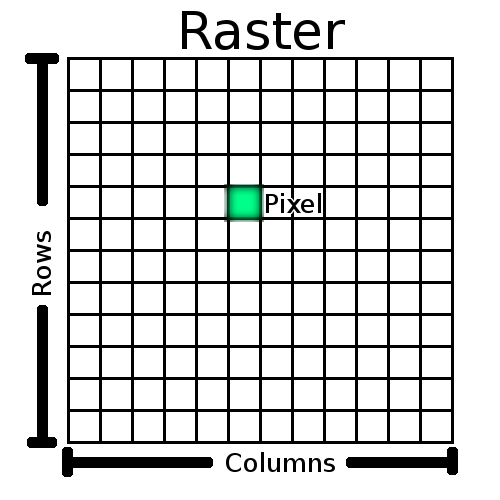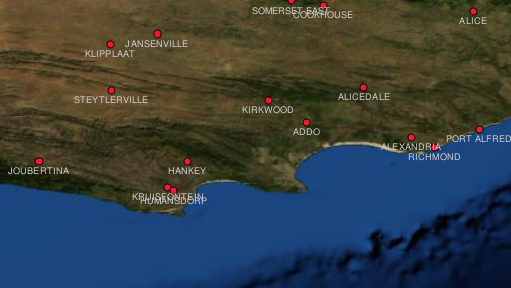ラスタ形式のデータ¶
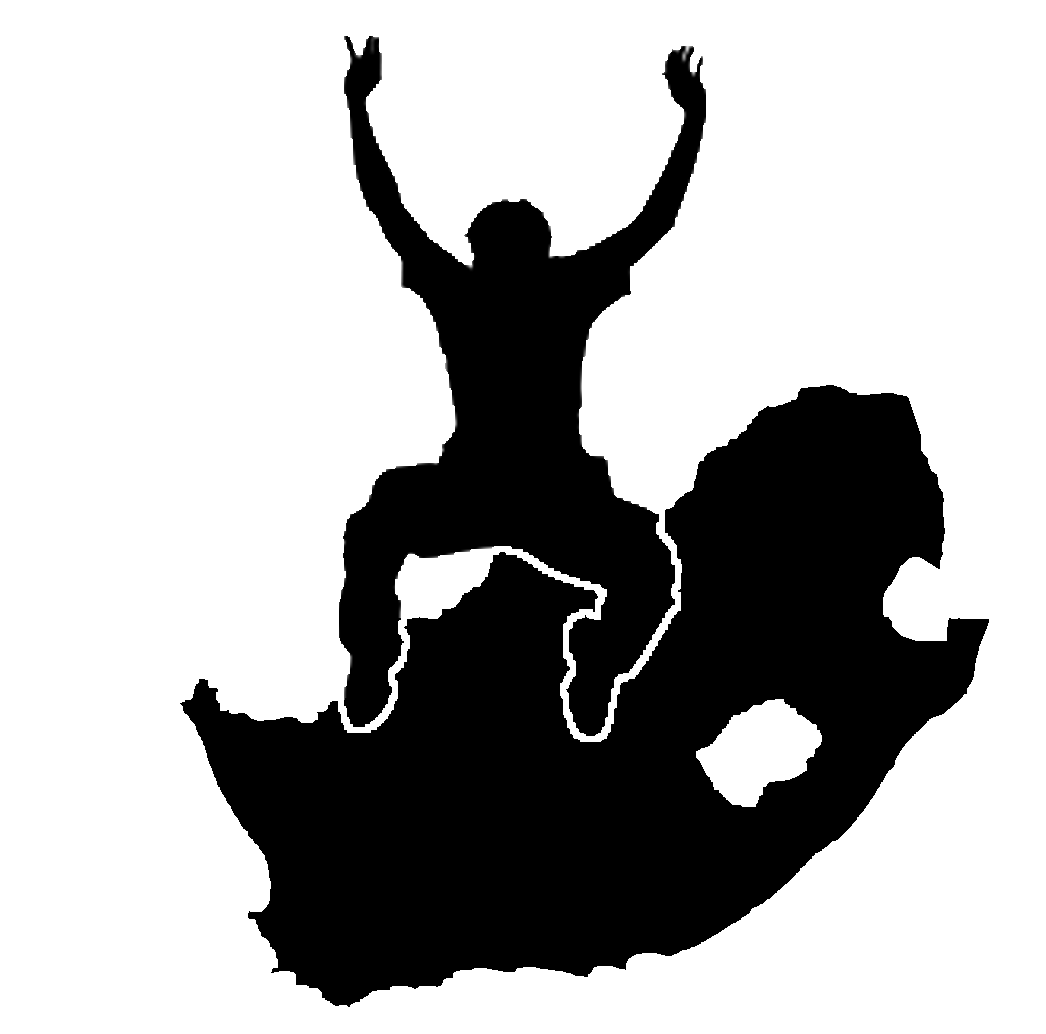 |
目的 |
ラスタデータとは何か、GISでそれがどのように利用可能かを理解します。 |
キーワード: |
ラスタ、ピクセル、リモートセンシング、衛星画像、ジオリファレンス |
概要¶
前のトピックでは、ベクタデータについて詳しく解説しました。ベクタ形式の地物は、ジオメトリ(ポイント、ポリライン、ポリゴン)を現実世界を表現するものとして使いますが、ラスタデータは違ったアプローチを取ります。ラスタはピクセルのマトリックスで構成されていて、それぞれがそのセル(figure_rasterを参照)でカバーされるエリアの状態を表す値を持っています。このトピックでは、ラスタデータについて、どんなときに利用でき、ベクタデータの方が利用価値が高いかについて詳しく解説します。
Figure Raster 1:
ラスタ形式データの詳細¶
連続的に地域を覆っていて、容易にベクタ地物に分解できない情報を表示しようとする際に、ラスタ形式のデータが用いられます。
Figure Landscape 1:

Some features on a landscape are easy to represent as points, polylines and polygons (e.g. trees, roads, houses). In other cases it can be difficult. For example how would you represent the grasslands? As polygons? What about the variations in colour you can see in the grass? When you are trying to represent large areas with continuously changing values, raster data can be a better choice.
Using raster data is a solution to these problems. Many people use raster data as a backdrop to be used behind vector layers in order to provide more meaning to the vector information. The human eye is very good at interpreting images and so using an image behind vector layers, results in maps with a lot more meaning. Raster data is not only good for images that depict the real world surface (e.g. satellite images and aerial photographs), they are also good for representing more abstract ideas. For example, rasters can be used to show rainfall trends over an area, or to depict the fire risk on a landscape. In these kinds of applications, each cell in the raster represents a different value e.g. risk of fire on a scale of one to ten.
衛星から取得した画像との差分を示す例であり、計算値は figure_raster_types で表示されます。
Figure Raster Types 1:

True colour raster images (left) are useful as they provide a lot of detail that is hard to capture as vector features but easy to see when looking at the raster image. Raster data can also be non-photographic data such as the raster layer shown on the right which shows the calculated average minimum temperature in the Western Cape for the month of March.
ジオリファレンス¶
Georeferencing is the process of defining exactly where on the earth’s surface an image or raster dataset was created. This positional information is stored with the digital version of the aerial photo. When the GIS application opens the photo, it uses the positional information to ensure that the photo appears in the correct place on the map. Normally this positional information consists of a coordinate for the top left pixel in the image, the size of each pixel in the X direction, the size of each pixel in the Y direction, and the amount (if any) by which the image is rotated. With these few pieces of information, the GIS application can ensure that raster data are displayed in the correct place. The georeferencing information for a raster is often provided in a small text file accompanying the raster.
ラスタデータのソース¶
Raster data can be obtained in a number of ways. Two of the most common ways are aerial photography and satellite imagery. In aerial photography, an aeroplane flies over an area with a camera mounted underneath it. The photographs are then imported into a computer and georeferenced. Satellite imagery is created when satellites orbiting the earth point special digital cameras towards the earth and then take an image of the area on earth they are passing over. Once the image has been taken it is sent back to earth using radio signals to special receiving stations such as the one shown in figure_csir_station. The process of capturing raster data from an aeroplane or satellite is called remote sensing.
Figure CSIR Station 1:
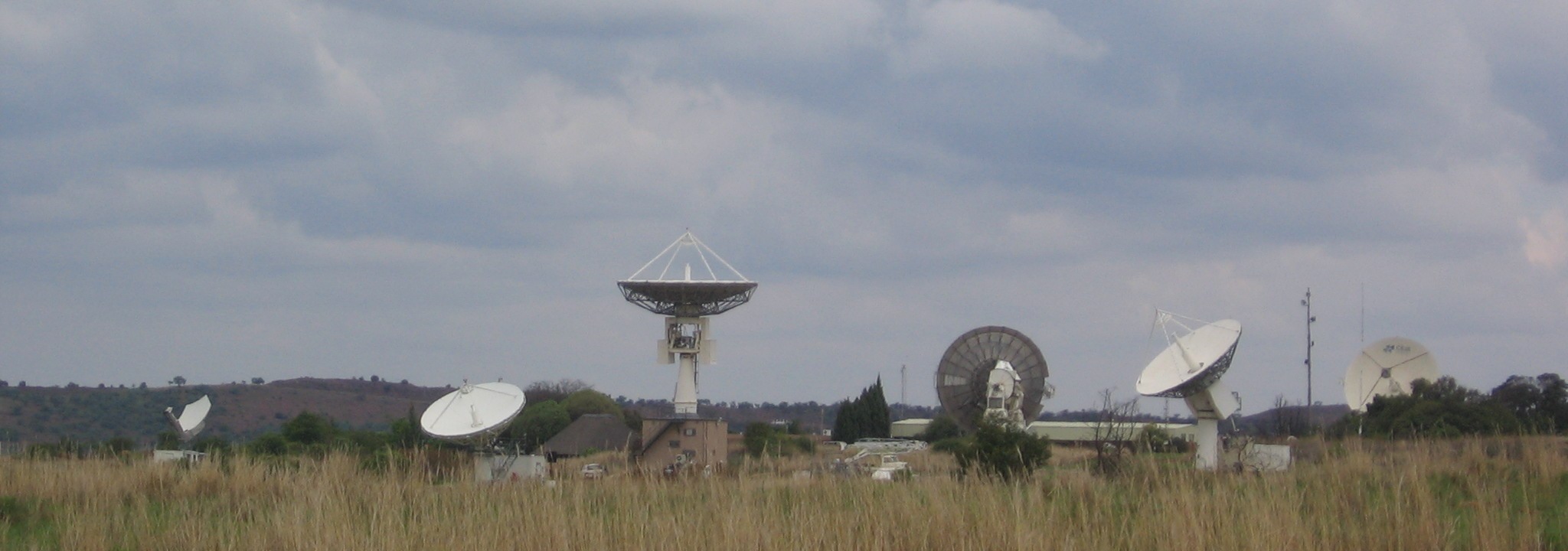
The CSIR Satellite Applications Center at Hartebeeshoek near Johannesburg. Special antennae track satellites as they pass overhead and download images using radio waves.
In other cases, raster data can be computed. For example an insurance company may take police crime incident reports and create a country wide raster map showing how high the incidence of crime is likely to be in each area. Meteorologists (people who study weather patterns) might generate a province level raster showing average temperature, rainfall and wind direction using data collected from weather stations (see figure_csir_station). In these cases, they will often use raster analysis techniques such as interpolation (which we describe in Topic 空間分析(補間)).
Sometimes raster data are created from vector data because the data owners want to share the data in an easy to use format. For example, a company with road, rail, cadastral and other vector datasets may choose to generate a raster version of these datasets so that employees can view these datasets in a web browser. This is normally only useful if the attributes, that users need to be aware of, can be represented on the map with labels or symbology. If the user needs to look at the attribute table for the data, providing it in raster format could be a bad choice because raster layers do not usually have any attribute data associated with them.
空間的解像度¶
Every raster layer in a GIS has pixels (cells) of a fixed size that determine its spatial resolution. This becomes apparent when you look at an image at a small scale (see figure_raster_small_scale) and then zoom in to a large scale (see figure_raster_large_scale).
Figure Raster Scale 1:
Figure Raster Scale 2:
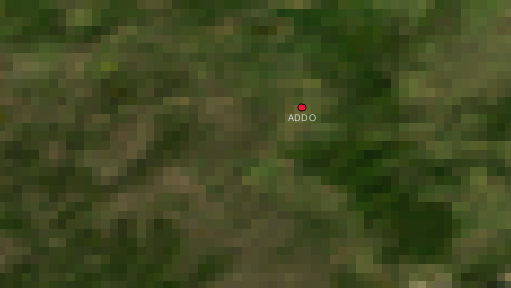
...but when viewed at a large scale you can see the individual pixels that the image is composed of.
Several factors determine the spatial resolution of an image. For remote sensing data, spatial resolution is usually determined by the capabilities of the sensor used to take an image. For example SPOT5 satellites can take images where each pixel is 10 m x 10 m. Other satellites, for example MODIS take images only at 500 m x 500 m per pixel. In aerial photography, pixel sizes of 50 cm x 50 cm are not uncommon. Images with a pixel size covering a small area are called ‘high resolution‘ images because it is possible to make out a high degree of detail in the image. Images with a pixel size covering a large area are called ‘low resolution‘ images because the amount of detail the images show is low.
In raster data that is computed by spatial analysis (such as the rainfall map we mentioned earlier), the spatial density of information used to create the raster will usually determine the spatial resolution. For example if you want to create a high resolution average rainfall map, you would ideally need many weather stations in close proximity to each other.
One of the main things to be aware of with rasters captured at a high spatial resolution is storage requirements. Think of a raster that is 3 x 3 pixels, each of which contains a number representing average rainfall. To store all the information contained in the raster, you will need to store 9 numbers in the computer’s memory. Now imagine you want to have a raster layer for the whole of South Africa with pixels of 1 km x 1 km. South Africa is around 1,219,090 km 2. Which means your computer would need to store over a million numbers on its hard disk in order to hold all of the information. Making the pixel size smaller would greatly increase the amount of storage needed.
Sometimes using a low spatial resolution is useful when you want to work with a large area and are not interested in looking at any one area in a lot of detail. The cloud maps you see on the weather report, are an example of this –– it’s useful to see the clouds across the whole country. Zooming in to one particular cloud in high resolution will not tell you very much about the upcoming weather!
一方、おそらく、画像から任意の個々のフィーチャを作ることができなくなるため、小さな領域に興味があるなら、低解像度のラスターデータを使用することは問題となる可能性があります。
スペクトルの解像度¶
If you take a colour photograph with a digital camera or camera on a cellphone, the camera uses electronic sensors to detect red, green and blue light. When the picture is displayed on a screen or printed out, the red, green and blue (RGB) information is combined to show you an image that your eyes can interpret. While the information is still in digital format though, this RGB information is stored in separate colour bands.
Whilst our eyes can only see RGB wavelengths, the electronic sensors in cameras are able to detect wavelengths that our eyes cannot. Of course in a hand held camera it probably doesn’t make sense to record information from the non-visible parts of the spectrum since most people just want to look at pictures of their dog or what have you. Raster images that include data for non-visible parts of the light spectrum are often referred to as multi-spectral images. In GIS recording the non-visible parts of the spectrum can be very useful. For example, measuring infra-red light can be useful in identifying water bodies.
Because having images containing multiple bands of light is so useful in GIS, raster data are often provided as multi-band images. Each band in the image is like a separate layer. The GIS will combine three of the bands and show them as red, green and blue so that the human eye can see them. The number of bands in a raster image is referred to as its spectral resolution.
If an image consists of only one band, it is often called a grayscale image. With grayscale images, you can apply false colouring to make the differences in values in the pixels more obvious. Images with false colouring applied are often referred to as pseudocolour images.
ラスタのベクタへの変換¶
In our discussion of vector data, we explained that often raster data are used as a backdrop layer, which is then used as a base from which vector features can be digitised.
Another approach is to use advanced computer programs to automatically extract vector features from images. Some features such as roads show in an image as a sudden change of colour from neighbouring pixels. The computer program looks for such colour changes and creates vector features as a result. This kind of functionality is normally only available in very specialised (and often expensive) GIS software.
ベクタのラスタへの変換¶
Sometimes it is useful to convert vector data into raster data. One side effect of this is that attribute data (that is attributes associated with the original vector data) will be lost when the conversion takes place. Having vectors converted to raster format can be useful though when you want to give GIS data to non GIS users. With the simpler raster formats, the person you give the raster image to can simply view it as an image on their computer without needing any special GIS software.
ラスタ分析¶
There are a great many analytical tools that can be run on raster data which cannot be used with vector data. For example, rasters can be used to model water flow over the land surface. This information can be used to calculate where watersheds and stream networks exist, based on the terrain.
Raster data are also often used in agriculture and forestry to manage crop production. For example with a satellite image of a farmer’s lands, you can identify areas where the plants are growing poorly and then use that information to apply more fertilizer on the affected areas only. Foresters use raster data to estimate how much timber can be harvested from an area.
Raster data is also very important for disaster management. Analysis of Digital Elevation Models (a kind of raster where each pixel contains the height above sea level) can then be used to identify areas that are likely to be flooded. This can then be used to target rescue and relief efforts to areas where it is needed the most.
一般的な問題 / 注意すべき点¶
すでに述べたように、高解像度のラスタデータは、コンピュータストレージを大量に必要となりえます。
わかりましたか?¶
ここでは以下のことを学びました:
ラスタデータは規則的な**ピクセル**のグリッドです。
ラスターデータは**たえず変化する情報**を表示するのに適しています。
ラスタ内のピクセルの大きさは、その**空間分解能**を決定します。
ラスタイメージは1つまたはそれ以上の**バンド**を含みます。それぞれが空間的なエリアをカバーするが、異なる情報を持ちます。
ラスタデータは、電磁スペクトルの異なる部分からのバンドが含まれている場合、それらは**マルチスペクトル画像**と呼ばれます。
それらを見ることができるように、マルチスペクトル画像のバンドの三つの色、赤、緑、青で表示することができます。
シングルバンドのイメージはグレースケールイメージと呼ばれます。
単一のバンドは、グレースケール画像は、GISにより疑似カラーで示すことができます。
ラスタ画像は、記憶領域を大量に消費することができます。
やってみよう¶
ここでは人に教える際のアイデアいくつか述べていきます:
ラスタデータを使用している状況で、ベクタデータを使用している学習者と議論しましょう。
- Get your learners to create a raster map of your school by using A4 transparency sheets with grid lines drawn on them. Overlay the transparencies onto a toposheet or aerial photograph of your school. Now let each learner or group of learners colour in cells that represent a certain type of feature e.g. building, playground, sports field, trees, footpaths etc. When they are all finished, overlay all the sheets together and see if it makes a good raster map representation of your school. Which types of features worked well when represented as rasters? How did your choice in cell size affect your ability to represent different feature types?
考えてみよう¶
If you don’t have a computer available, you can understand raster data using pen and paper. Draw a grid of squares onto a sheet of paper to represent your soccer field. Fill the grid in with numbers representing values for grass cover on your soccer field. If a patch is bare give the cell a value of 0. If the patch is mixed bare and covered, give it a value of 1. If an area is completely covered with grass, give it a value of 2. Now use pencil crayons to colour the cells based on their values. Colour cells with value 2 dark green. Value 1 should get coloured light green, and value 0 coloured in brown. When you finish, you should have a raster map of your soccer field!
より詳しく知りたい場合は¶
図書:
- Chang, Kang-Tsung (2006). Introduction to Geographic Information Systems. 3rd Edition. McGraw Hill. ISBN: 0070658986
- DeMers, Michael N. (2005). Fundamentals of Geographic Information Systems. 3rd Edition. Wiley. ISBN: 9814126195
Webサイト: http://en.wikipedia.org/wiki/GIS#Raster
QGISユーザーガイドでは, ラスタデータの操作についてより詳細な情報が含まれています.
次は?¶
In the section that follows we will take a closer look at topology to see how the relationship between vector features can be used to ensure the best data quality.
